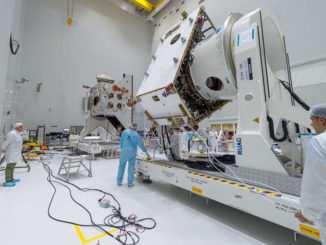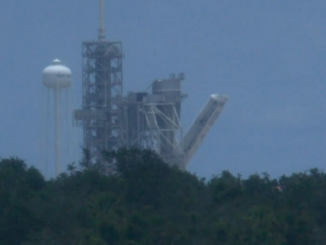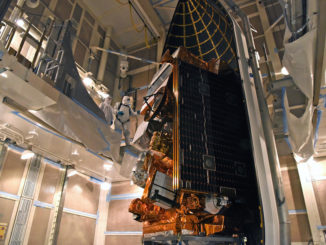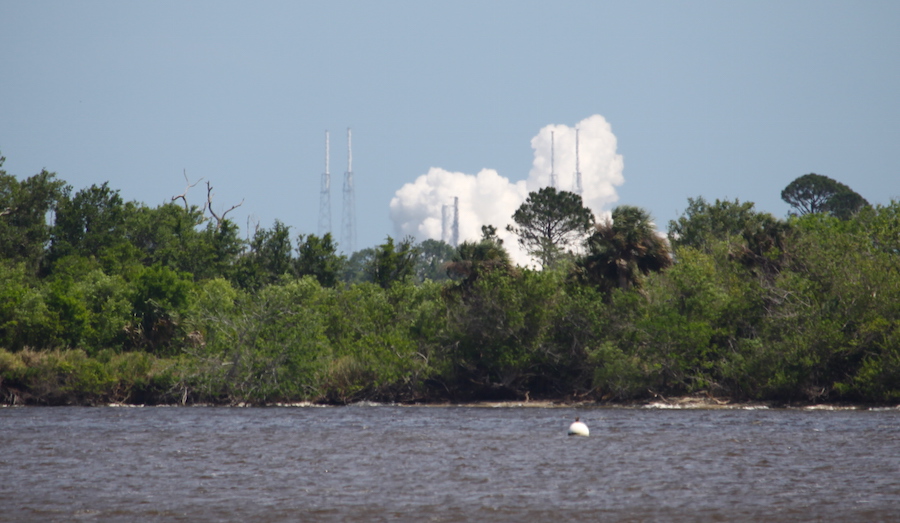
SpaceX’s launch team loaded super-chilled liquid propellants into a two-stage Falcon 9 rocket Wednesday and fired the booster’s nine first stage engines at Cape Canaveral, marching toward liftoff Monday with a NASA observatory built to find planets around other stars in our galactic neighborhood.
The Falcon 9’s nine Merlin 1D booster engines ignited at 2:30 p.m. EDT (1830 GMT) Wednesday as hold-down clamps kept the rocket firmly on Earth at Cape Canaveral’s Complex 40 launch pad. A plume of exhaust visible from nearby viewing points appeared at the launch pad, and SpaceX tweeted later Wednesday that the static fire test was complete.
The hold-down firing was a key milestone in the run-up to launch Monday of NASA’s Transiting Exoplanet Survey Satellite, an approximately $337 million mission that will survey the sky in search of tell-tale dips in light from bright, nearby stars. The brief, slight reduction in brightness registered by TESS could be evidence of a planet passing in front of the star.
TESS will be the first NASA space science satellite to launch on a SpaceX rocket, and it’s the space agency’s second mission devoted to finding and cataloguing exoplanets.
NASA’s Kepler observatory, launched in March 2009, looked for planets around stars residing in a section of the sky in the constellations Cygnus and Lyra, then expanded its survey to observe other parts of the sky in the ecliptic plane, the relatively flat imaginary plane where our solar system’s planets reside.
Kepler has found more than confirmed 2,652 exoplanets, and 2,724 candidate discoveries await follow-up observations before astronomers declare those detections as real planets, according to data published in NASA’s exoplanet archive. Looping around the sun in an Earth-trailing heliocentric orbit, Kepler has discovered more than 70 percent of all the known exoplanets to date.
But TESS will look for exoplanets across 85 percent of the sky, giving astronomers a more three-dimensional survey of worlds lurking in other solar systems, focusing on bright stars that are in the same part of the Milky Way galaxy as the sun.
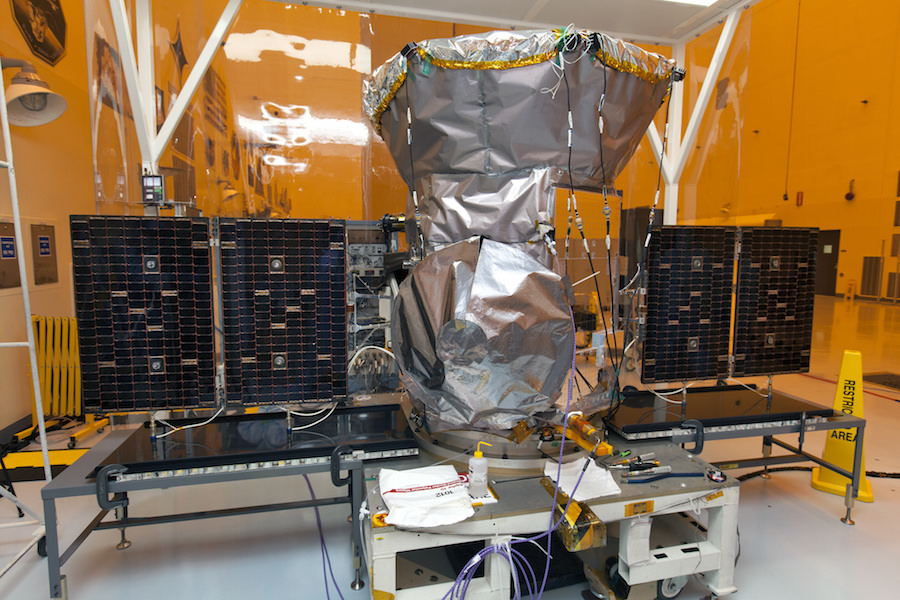
The new TESS observatory will “build upon the legacy of the Kepler mission, only it is going to focus on nearby bright stars that are sprinkled across the whole sky, and it’s going to help us answer a really important question: Which of our nearest stellar neighbors have planets?” said Elisa Quintana, an astrophysicist and TESS mission support scientist at NASA’s Goddard Space Flight Center in Maryland.
TESS carries four science cameras developed by MIT’s Kavli Institute for Astrophysics and Space Research and the MIT Lincoln Laboratory. Each camera contains a 16.8-megapixel sensor covering a field of view of 24-by-24 degrees, with the sensitivity to detect faint dips in star brightness and a coverage area wide enough to look at thousands of targets.
“The coverage of the TESS cameras is unprecedented in terms of the amount of sky that they can actually see at any given time, and also their ability to cover such a broad portion of the sky,” said George Ricker, the mission’s principal investigator from MIT. “The types of targets that TESS will allow us to find will enclose essentially all the bright nearby stars.”
Liftoff of TESS is scheduled for 6:32:07 p.m. EDT (2232:07 GMT) Monday from pad 40 at Cape Canaveral. The day’s launch window extends for 30 seconds.
TESS will launch into an egg-shaped preliminary orbit stretching as far as 155,000 miles (250,000 kilometers) from Earth, around 60 percent of the distance to the moon. Once deployed from the Falcon 9’s second stage, the roughly 815-pound (370-kilogram) spacecraft will fire thrusters to boost the farthest arc of its orbit to intercept the moon.
TESS will swing by the moon, using lunar gravity to slingshot toward the mission’s operating orbit. A final major maneuver will steer the satellite on a path taking it around the planet once every two weeks in a 2:1 resonance with the moon, with distances ranging between 67,000 miles (108,000 kilometers) and 233,000 miles (376,000 kilometers) from Earth.
“The Falcon 9 does a lot of the lifting for us, and then the moon does most of the rest of it,” said Robert Lockwood, TESS program director at Orbital ATK, which built the spacecraft.
The launch of TESS is timed to ensure the moon is in the right place in its orbit around Earth to allow the satellite to make its crucial lunar flyby. If Monday’s launch is delayed or scrubbed, launch opportunities will not be available on some days due to moon’s orbital dynamics.
But Ricker said Wednesday that TESS can blast off any day through April 21, before waiting for a new block of potential launch dates around the end of April.
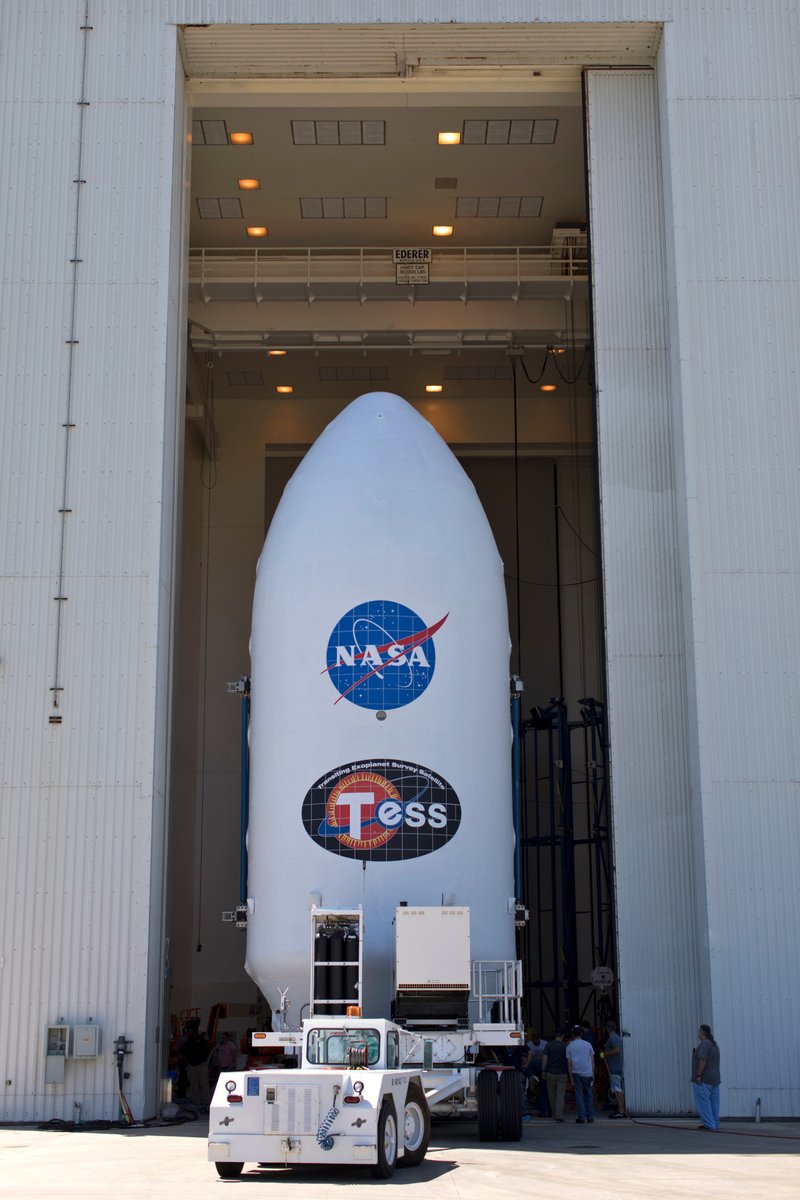
Since arriving at the Kennedy Space Center in February, TESS has been fueled with maneuvering propellant for its rocket thrusters, and encapsulated inside the Falcon 9 rocket’s payload fairing, the aerodynamic shell that will protect the spacecraft during the first few minutes of launch.
Now that the static fire test is complete, the TESS spacecraft and the rocket’s nose cone will be moved to SpaceX’s hangar at pad 40, where ground crews will install the payload once the Falcon 9 is lowered off its launch mount and rolled back inside.
The Falcon 9 rocket assigned to the TESS mission will fly with a new first stage booster, and SpaceX is expected to attempt to recover the stage on a drone ship in the Atlantic Ocean for potential refurbishment and reuse. TESS will launch with the final newly-manufactured “Block 4” version of SpaceX’s workhorse rocket, before several upgrades will debut in a new “Block 5” version set to launch for the first time in early May.
It will take around two months for TESS to settle into its unusual orbit and complete post-launch testing. Then scientists will press the observatory into a two-year mission searching for exoplanets.
Ricker proposed the TESS mission to NASA in 2012, and the project won government funding the next year. Now the mission is days from launch.
“It feels wonderful in one way,” Ricker said in an interview with Spaceflight Now. “It’s a little bit daunting because now that it’s really going to happen, we’ll see the rocket light and that will be all that we can conceivably do. We’ve done pretty much everything we can with the instruments and the spacecraft by delivering them here to Kennedy (Space Center) so that the launch preparations can really occur in earnest.”
Expect some new worlds added to the exoplanet count by the end of the year.
“I think there’s going to be a teething problem as there always will be with a new satellite,” Ricker said. “So it will probably be some time in the fall before we have some interesting results to share.”
Email the author.
Follow Stephen Clark on Twitter: @StephenClark1.

